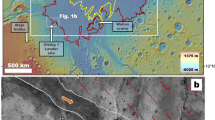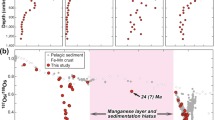Abstract
In 1995, an expedition on board the research vessel FS Polarstern explored the impact site of the Eltanin asteroid in the Southern Ocean, the only known asteroidimpact into a deep ocean basin. Analyses of the geological record of the impact region place the event in the late Pliocene (∼2.15 Myr) and constrain thesize of the asteroid to be >1 km. The explosive force inferred for this event places it at the threshold of impacts believed to have global consequences, and its studyshould therefore provide a baseline for the reconstruction and modelling of similar events, which are common on geological timescales.
This is a preview of subscription content, access via your institution
Access options
Subscribe to this journal
Receive 51 print issues and online access
$199.00 per year
only $3.90 per issue
Buy this article
- Purchase on Springer Link
- Instant access to full article PDF
Prices may be subject to local taxes which are calculated during checkout






Similar content being viewed by others
References
Grieve, R. A. F. & Shoemaker, E. M. in Hazards Due to Comets and Asteroids(ed. Gehrels, T.) 417–462 (Univ. Arizona Press, (1994)).
Kyte, F. T., Zhou, Z. & Wasson, J. T. High noble metal concentrations in a late Pliocene sediment. Nature 292, 417–420 (1981).
Kyte, F. T., Zhou, L. & Wasson, J. T. New evidence on the size and possible effects of a late Pliocene oceanic impact. Science 241, 63–65 (1988).
Kyte, F. T. & Brownlee, D. E. Unmelted meteoritic debris in the Late Pliocene Ir anomaly: evidence for the impact of a nonchrondritic asteroid. Geochim. Cosmochim. Acta 49, 1095–1108 (1985).
Margolis, S. V., Claeys, P. & Kyte, F. T. Microtektites, microkrystites and spinels from a late Pliocene asteroid impact in the Southern Ocean. Science 251, 1594–1597 (1990).
Kyte, F. T. & Smit, J. Regional variation in spinel compositions: an important key to the Cretaceous–Tertiary event. Geology 14, 485–487 (1986).
Melosh, H. J. Impact Cratering(Oxford Univ. Press, New York, (1989)).
Cande, S. C., Herron, E. M. & Hall, B. R. The early Cenozoic history of the southeast Pacific. Earth Planet. Sci. Lett. 57, 63–74 (1982).
Gersonde, R. & Barcena, M. A. Revision of the upper Pliocene–Pleistocene diatom biostratigraphy for the northern belt of the Southern Ocean. Micropaleontology(in the press).
Cande, S. C. & Kent, D. V. J. Revised calibration of the geomagnetic polarity timescale for the Late Cretaceous and Cenozoic. Geophys. Res. 100(B4), 6093–6095 (1995).
Anonymous. Marine Geology USNS Eltanin Cruses 9–15, coredescriptionandlocations. (Contr. 11, Sedimentology Research Laboratory, Dept. of Geology, Florida State Univ., (1965)).
Wei, W. Calibration of upper Eocene–lower Pleistocene nannofossil events with oxygen isotope stratigraphy. Paleoceanography 8, 85–99 (1992).
Gorbunova, Z. N. Clay-size minerals from cores of the southeast Pacific Ocean. Init. Rep. DSDP 35, 479–488 (1976).
O'Keefe, J. D. & Ahrens, T. Impact mechanics of the Cretaceous–Tertiary extinction bolide. J. Lunar Planet. Sci. 12, 785–787 (1981).
Chapman, C. R. & Morrison, D. Impacts on the Earth by asteroids and comets: assessing the hazard. Nature 367, 33–40 (1994).
Toon, O. B., Zahnie, K., Morrison, D., Turco, R. P. & Covey, C. Environmental perturbances caused by the impacts of asteroids and comets. Rev. Geophys. 35, 41–78 (1997).
Hills, J. G., Nemchinov, I. V., Popov, S. P. & Teterev, A. V. in Hazards Due to Comets and Asteroids(ed. Gehrels, T.) 779–789 (Univ. Arizona Press, (1994)).
Muizon, C. de. Les vertébrés fossiles de la formation Pisco (Pérou). 1: Deux nouveaux Monochinae (Phocidae, Mammalia) du Pliocène de Sud-Sacaco.(Inst. Francais d'études Andines, Édit. recherche sur les Civilisations, Mémoire 6, Paris, (1981)).
Quilty, P. G. in Recent Progress in Antarctic Earth Science(ed. Yoshida, Y.) 699–705 (Terra Scientific, Tokyo, (1992)).
Hall, B. L., Denton, G. H., Lux, D. R. & Schlüchter, C. Pliocene paleoenvironment and Antarctic ice sheet behavior: evidence from Wright Valley. J. Geol. 105, 285–294 (1997).
Bruno, L. A., Baur, H., Graf, T., Schlüchter, C., Signer, P. & Wieler, R. Dating of Sirius Group tillites in the Antarctic Dry Valleys with cosmogenic 3He and 21Ne. Earth Planet. Sci. Lett. 147, 37–54 (1997).
Harwood, D. M. Diatoms from the Sirius Formation, Transantarctic Mountains. Antarctic J. 18, 98–100 (1983).
Webb, P.-N., Harwood, D. M., McKelvey, B. C., Mercer, J. H. & Stott, L. D. Cenozoic marine sedimentation and ice volume variation on the east Antarctic craton. Geology 12, 287–291 (1984).
Webb, P.-N. & Harwood, D. M. Late Cenozoic glacial history of the Ross Embayment, Antarctica. Quat. Sci. Rev. 10, 215–223 (1991).
Barrett, P. J., Adams, C. J., McIntosh, W. C., Swisher, C. C. II & Wilson, G. S. Geochronological evidence supporting Antarctic deglaciation three million years ago. Nature 359, 816–818 (1992).
Sugden, D. E., Marchant, D. R., Potter, N. J, Souchez, R. A., Denton, G. H., Swisher, C. C. II & Tison, J.-L. Preservation of Miocene glacier ice in east Antarctica. Nature 376, 412–414 (1995).
Kennett, J. P. & Hodell, D. A. Evidence for relative climatic stability on Antarctica during the early Pliocene: a marine perspective. Geograf. Ann. 75, 205–220 (1993).
Kellogg, D. E. & Kellogg, T. B. Non-marine diatoms in the Sirius Formation. Antarctic J. 19, 44–45 (1984).
Barrett, P. J., Bleakly, N. L., Dickinson, W. W., Hannah, M. J. & Harper, M. A. Distribution of siliceous microfossils on Mount Feather, Antarctica, and the age of the Sirius Group. Proc. Terra Antarctica 3, (in the press).
Burckle, L. H. & Potter, N. Jr. Pliocene–Pleistocene diatoms in Paleozoic and Mesozoic sedimentary and igneous rocks from Antarctica: a Sirius problem solved. Geology 24, 235–238 (1996).
Stroeven, A. P., Pentrice, M. L. & Kleman, J. On marine microfossil transport and pathways in Antarctica during the late Neogene: evidence from the Sirius Group at Mount Fleming. Geology 24, 727–730 (1996).
Shackleton, N. J., Hall, M. A. & Pate, D. Pliocene stable isotope stratigraphy of Site 846. Proc. ODP Sci. Res. 138, 337–355 (1995).
Raffi, I., Backman, J., Rio, D., Shackleton, N. J. Plio-Pleistocene nannofossil biostratigraphy and calibration to oxygen isotope stratigraphies from Deep Sea Drilling Project Site 607 and Ocean Drilling Program Site 677. Paleoceanography 8, 387–408 (1993).
Perch-Nielsen, K. in Plankton Stratigraphy Vol. 1(eds Bolli, H. B., Saunders, J. B. & Perch-Nielsen, K.) 427–554 (Cambridge Univ. Press, (1985)).
Berggren, W. A., Kent, D. V., Swisher, C. C. II & Aubry, M.-P. in Geochronology Timescales and Global Stratigraphic Correlation(eds Berggren, W. A., Kent, D. V., Aubry, M.-P. & Hardenbol, J.) 129–212 (Spec. Publ. 54, Soc. of Economic Paleontologists and Mineralogists, (1995)).
Acknowledgements
This research was supported by Acciones Integradas grants to R.G. and J.A.F., and an NSF grant to F.T.K. and J.A.B. We thank the crew of RV Polarstern for their substantial support.
Author information
Authors and Affiliations
Corresponding author
Rights and permissions
About this article
Cite this article
Gersonde, R., Kyte, F., Bleil, U. et al. Geological record and reconstruction of the late Pliocene impact of the Eltanin asteroid in the Southern Ocean. Nature 390, 357–363 (1997). https://doi.org/10.1038/37044
Issue Date:
DOI: https://doi.org/10.1038/37044
This article is cited by
-
A Miocene impact ejecta layer in the pelagic Pacific Ocean
Scientific Reports (2019)
-
Impacts of Cosmic Dust on Planetary Atmospheres and Surfaces
Space Science Reviews (2018)
-
Windblown Pliocene diatoms and East Antarctic Ice Sheet retreat
Nature Communications (2016)
-
Fossil proxies of near-shore sea surface temperatures and seasonality from the late Neogene Antarctic shelf
Naturwissenschaften (2013)
-
Calculations of Asteroid Impacts into Deep and Shallow Water
Pure and Applied Geophysics (2011)
Comments
By submitting a comment you agree to abide by our Terms and Community Guidelines. If you find something abusive or that does not comply with our terms or guidelines please flag it as inappropriate.



